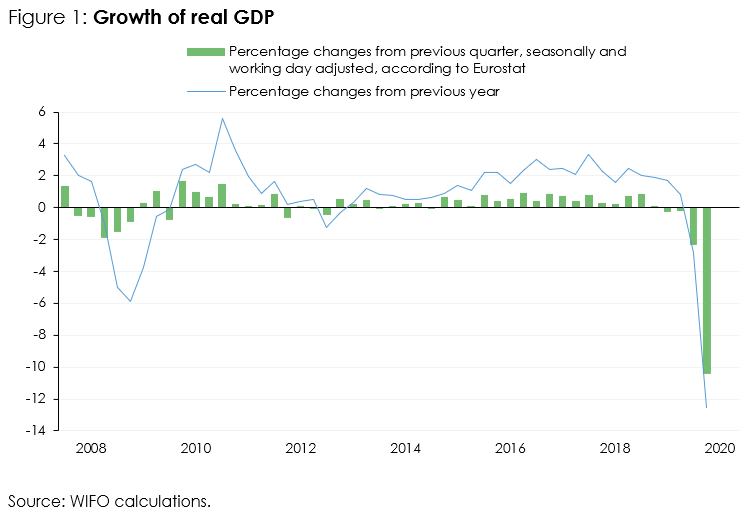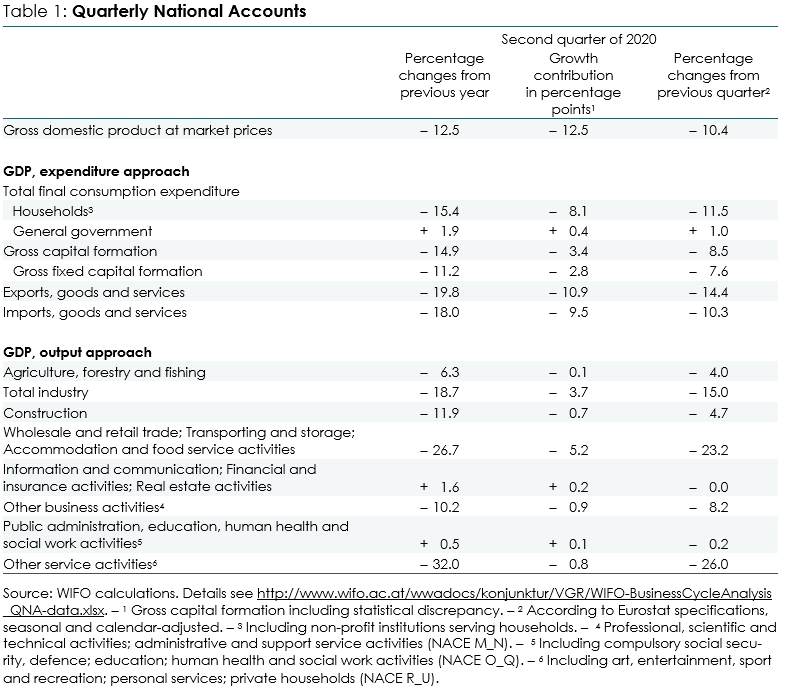
GDP Decline of 12.5 Percent in the Second Quarter of 2020 Compared to Previous Year
Important information:
The current situation requires changes in both the compilation and publication of economic data. The data in this calculation are considered to be provisional, are subject to greater uncertainty and will probably be subject to greater revision than usual.
Furthermore, WIFO will refrain from publishing the trend-cycle data until further notice, as the usual informative value of this component is not available due to the sharp decline at the current edge. Instead, presentation and description focus on the unadjusted annual rates of change as well as on the seasonally and working day adjusted rate of change compared to the previous quarter (key figure according to Eurostat). Both indicators best reflect the economic slump – at least in the recent analysis.
According to current calculations, economic output in the second quarter of 2020 was 12.5 percent below the level of the previous year. Compared with the previous quarter, GDP fell by 10.4 percent (key figure according to Eurostat specifications). With this calculation the result of the flash estimate (–12.8 percent year-on-year and 10.7 percent quarter-on-quarter) from the end of July has only been revised slightly upwards.
The economic effects of the COVID-19 pandemic and the related measures were also evident in the euro area and the EU. In the euro area, seasonally adjusted GDP fell by 12.1 percent in the second quarter compared with the previous quarter, and by 11.7 percent in the EU. Both nationally and internationally, this decline proved to be unique in the recent past.
The Austrian economy declined across the board in the second quarter, with both domestic demand and export demand falling massively. Private consumption was particularly affected. As a result of restrictions in trade and service sectors, it fell by 15.4 percent compared with the previous year and significantly dampened GDP (–8.1 percentage points). By contrast, public consumption had a stabilising effect. Investment activity was significantly reduced (gross fixed capital formation –11.2 percent year-on-year). Here, both investment in machinery and equipment (–18.3 percent) and investment in construction (–10.9 percent) fell.

As a result of the global economic downturn, a significant decline in export activity was recorded (–19.8 percent). This affected both goods (–17.2 percent) and services (–26.5 percent), whereby the massive slump in tourism exports dampened development. Imports were currently 18.0 percent (goods –16.0 percent; services –23.2 percent) below the previous year's level, so that foreign trade made a negative contribution to growth.
On the production side, the service sectors developed unevenly, with a massive drop in value added in the consumer-related sectors. Value added in the wholesale and retail trade, repair of motor vehicles and motorcycles, transportation and storage, accommodation and food service activities declined by 26.7 percent compared to the previous year (contribution to growth –5.2 percentage points). The sectors including art, entertainment, sport and recreation and personal services were also heavily affected by the measures to contain the pandemic (value added –32 percent). In contrast, economic development in the areas of information and communication, financial and insurance activities and real estate activities stabilised domestic economic growth in the second quarter.
The consequences of the COVID-19 pandemic also had a negative impact on the industrial and construction sectors. Value added in manufacturing slumped by 20.4 percent and in the construction industry by 11.9 percent.

Publications
Please contact
























